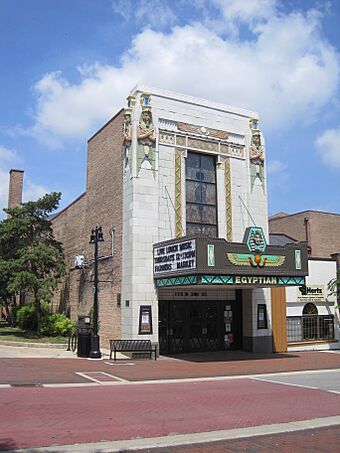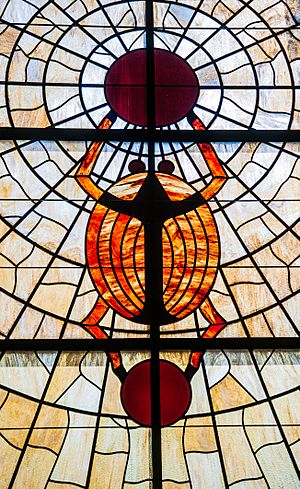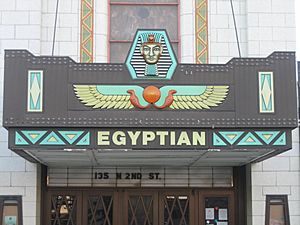Egyptian Theatre (DeKalb, Illinois) facts for kids
Quick facts for kids |
|
|
Egyptian Theatre
|
|

The Egyptian Theatre in DeKalb, Illinois
|
|
| Location | DeKalb, DeKalb County, Illinois |
|---|---|
| Built | 1928–29 |
| Architect | Elmer F. Behrns |
| Architectural style | Egyptian Revival |
| NRHP reference No. | 78003100 |
| Added to NRHP | December 1, 1978 |
The Egyptian Theatre in DeKalb, Illinois, is a special building. It looks like ancient Egyptian temples and tombs. This style is called Egyptian Revival. The theatre was built in 1928 and 1929. People were very interested in Ancient Egypt back then. This was because Tutankhamun's tomb was discovered in 1922.
The theatre was added to the U.S. National Register of Historic Places in 1978. This means it's an important historical place. It has 1,430 seats, making it the biggest auditorium in DeKalb County.
The building was designed by an architect named Elmer F. Behrns. He loved Egyptology, which is the study of ancient Egypt. The inside and outside of the theatre show many Egyptian symbols. For example, the stained glass windows show Ra, the Egyptian sun god, and the scarab. The scarab is a sacred Egyptian symbol.
In the 1970s, the theatre was almost torn down. But a group called Preservation of the Egyptian Theatre (PET) saved it. There have been many stories about secret messages hidden in the theatre's design. People also talk about ghosts haunting the building. The theatre says there are no hidden messages. However, the ghost stories are still popular! The Egyptian Theatre is open for about 42 weeks each year. It hosts up to 125 events annually.
Contents
History of the Egyptian Theatre
When the Egyptian Theatre opened in 1929, many other "Egyptian Theatres" were built across the United States. Today, the DeKalb theatre is one of only a few still standing. The original plan was to build more buildings attached to the theatre. For example, a hotel was supposed to be next to it. But these plans were stopped because of the stock market crash in late 1929.
In its early days, the theatre showed silent films. It also hosted live vaudevillian shows. Vaudeville was a type of entertainment with different acts like music, comedy, and dance.
As time went on, the theatre focused more on showing movies. This continued through the 1940s, 50s, and 60s. By the 1970s, the theatre was in bad shape. Its plaster walls were falling apart. The owner gave the theatre to the city of DeKalb. In 1978, a group of citizens came together to save and restore it. This group was called Preservation of the Egyptian Theatre (PET).
When the Egyptian Theatre was listed on the National Register of Historic Places in 1980, PET received a large grant. This money helped them start restoring the theatre. However, they needed more money than they received. So, some projects had to be cut. For example, the building never had air conditioning, and it still doesn't.
As of 2007, PET, a non-profit organization, runs the theatre. Since the restoration in the 1980s, the theatre has hosted many different films and events. The sign outside the theatre, called a marquee, was installed in 1982. It is the fourth marquee the building has had.
The Egyptian Theatre has a 42-week season each year. It hosts around 125 events. The season is shorter because of the hot summers in northern Illinois. Remember, the theatre does not have air conditioning! In 2006, many groups used the theatre. These included professional groups, student organizations, and departments from nearby Northern Illinois University.
Many famous performers have appeared at the Egyptian Theatre. These include Journey (1977), Heart (1977), R.E.M. (1984), Tori Amos (1994), Rick Springfield (2013), and Lewis Black (2015). Other notable performers include Scotty McCreery (2019), Arlo Guthrie (2019), Jesse McCartney (2021), and Mavis Staples (2023). The theatre hosts Gaelic Storm every year. It also features several tribute bands.
In January 2019, the theatre announced a big renovation project. This project cost $5.5 million. It included adding air conditioning to protect the building. It also made changes to meet modern accessibility standards. Theatre officials planned to reopen in 2020.
Egyptian Theatre Architecture
The DeKalb Egyptian Theatre is one of about one hundred Egyptian-style theatres built in the early 1900s. It is believed to be one of only six still standing in the United States. This theatre is more than just a mix of hieroglyphics and symbols. The architect, Elmer F. Behrns, loved Egyptology. He designed the theatre with one main idea in mind. Behrns' theme for the DeKalb Egyptian was based on Pharaoh Ramses II.

The outside of the theatre is covered in light green terra cotta. It has a huge 20-foot (6.1 m) tall stained glass window. This window shows the ancient scarab symbol. The scarab is holding up the sun god Ra while standing on top of the Earth. On each side of the stained glass window, there are two huge pharaoh statues. They look like they are "guarding" the theatre entrance. The entire front of the theatre looks like the gate of a grand Egyptian temple.
The small outer lobby feels like entering the first room of an ancient Egyptian tomb. The walls of this lobby are made of large, plain blocks. They look like sandstone. The front of the ticket booth is a dark red color. It has a golden sunburst design above the window. After passing through the glass doors into the main lobby, you can see the original mosaic-tiled floor. The ceiling is very tall, reaching 40 feet (12.2 m) high.
The walls of the main lobby are cream-colored plaster. Eight pillars and cornices surround them. These are decorated with golden lotus blossoms and palm leaves. High up on the walls, between each pillar, are six large golden plaster urns. These urns are also decorated with lotus buds and palm leaves. They have a gilded design with outstretched falcon wings and the sun's disc. Golden serpents are wrapped around them. The lotus design is also on the frosted wall sconces below the urns. It is also on the chandelier hanging over the center of the double staircase. This staircase leads to the mezzanine and balcony.
The auditorium's design and decorations are meant to look like a royal Egyptian courtyard. The stage is a good size, about 35 feet (10.7 m) across. However, the backstage area is very small. This is because it was originally used for vaudeville shows. When the theatre first opened, it had 1,600 seats. After the renovation in the 1980s, it had 1,483 seats. Four more seats were removed in 2000 to follow disability laws. The 1,430-seat auditorium is the largest in DeKalb County.
Ghost Stories at the Egyptian Theatre
The DeKalb Egyptian Theatre, like many other Egyptian Revival buildings, is designed to feel mysterious. The ancient Egyptian symbols have led to a popular belief. Many people think there are hidden meanings in the theatre's design and colors. However, in 2006, a theatre spokesperson said that the colors and decorations were chosen only for their beauty.
Even though there are no hidden messages, many people have reported strange things happening. The Egyptian Theatre is widely rumored to be home to two ghosts. One ghost is said to be Irv Kummerfeldt. He was a co-founder of PET. He had a heart attack and passed away at the top of "Aisle One" in the theatre's auditorium. His ghost has been reported in that area ever since.
The second ghost is called "Bob" by theatre workers. Bob moves around much more freely. People have seen Bob throughout the building. Objects have moved by themselves. Doors have opened on their own. People have felt a tap on their shoulder when no one else was around. Sometimes, footsteps have been heard echoing across the auditorium. The theatre operators and preservationists take these ghost stories seriously. They even look through old newspapers to try and find out who Bob might have been.
Why the Egyptian Theatre is Important
The Egyptian Theatre is one of the few Egyptian theatres left in the United States. Depending on how you count, there are only six or more Egyptian Revival theatres remaining. The Illinois Main Street association called the DeKalb Egyptian "one of Illinois' great buildings." The Egyptian Theatre was added to the U.S. National Register of Historic Places on December 1, 1978.
See also
- Egyptian Theatre (Coos Bay, Oregon)
- Grauman's Egyptian Theatre – Hollywood, California
- Peery's Egyptian Theatre – Ogden, Utah
- Mary G. Steiner Egyptian Theatre – Park City, Utah
- The Egyptian Theatre (Boise, Idaho)


